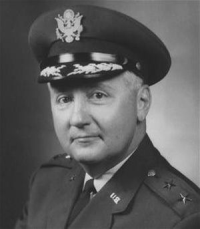Major General John E. Morrison Jr., USAF (Ret)

John E. Morrison Jr. was born on April 20, 1918 in Baltimore and graduated from the University of Baltimore in 1939 with a Juris Doctor degree. He graduated from the Air Command and Staff College in 1949 and from the Air War College in 1959.
Maj Gen Morrison was a member of the Board of Directors of the National Historical Intelligence Museum; founder, past president, and Chairman of the Board of the National Cryptologic Museum Foundation; and a member of the Joint Military Intelligence College Foundation Board. He was also a Phoenix Society Distinguished Member.
Maj Gen Morrison's accomplishments were many and varied but two of Gen Morrison's proudest accomplishments were the creation of the NSA's National SIGINT Operations Center and his co-sponsorship of the AKA Smart (All Kids are Smart) program that introduced cryptology to local school curriculums. Read his biography at the USAF website and read about his accomplishments in the article written for his 2001 induction into the Cryptologic Hall of Honor by visiting the NSA website.
John E. Morrison, 94, a 40-year resident of Davidsonville, MD, died on January 11. 2013 at his home.
The NCMF established The Major General John E. Morrison Award in Excellence and Innovation as part of its participation with the Maryland History Day Competition. The Morrison Award is for outstanding projects that address topics related to the history of science and technology. The $500.00 donation sponsors two achievement awards – one in the junior division (grades 6 through 8) and one in the senior division (grades 9 through 12).
Sponsored for the In Memoriam Panel by NCMF friends & colleagues. Sponsored for the In Memoriam Registry by family members, Pat Zasodil, Daughter, Grandchildren Laura, Kimberly & John Zasodil, Karen & Will Phillips, Frank & Terri Saus, Bill Saadi, Sharon & Al Maneki, Wendy & George Cotter, John Crandel, Jr., Lt. Col. Selmer Norland, USA (Ret), George Lawrence, David D'Auria, James Current, Keith Hall, Mary Faletto, Nancy Arteche, Kevin Crouse, Kay & Bob Hunt, Samuel Prum, Anthony Ward, Bill Sullivan, Harry Rosenbluh, Barbara MCNamara, James Thompson, Andy Batmanghelidj, David & Martha Gaddy, and Richard Bernard.
* Maj Gen John E. Morrison Jr., USAF (Ret) was inducted into the NSA Cryptologic Hall of Honor in 2001. The text below is from his Hall of Honor page.
During a distinguished career spanning 60 years, including 32 years in the military, John E. Morrison has been instrumental in shaping the signals intelligence community.
From 1946 to 1973, Major General Morrison had tours as Assistant to the Air Force member of the United States Communications Intelligence Board; member of the faculty of the Air Command and Staff School; Commander, 3rd Radio Squadron Mobile in Alaska; Assistant Deputy Chief of Staff, Operations, USAFSS; Commander, Air Force Special Communications Center; Air Force Coordinator for the Military Communications Electronics Board (JCS); Chief, Policy and Objectives Division of the Directorate of Telecommunications, USAF; Assistant Director of the Defense Communications Agency (DCA) for Plans and Programs; Chief, NSA, Pacific; and, at NSA Headquarters, Deputy Assistant Director for Production (DADP) and Assistant Director for Production (ADP).
His accomplishments in these positions were many and varied. While serving on the Air Staff in the Directorate of Telecommunications, he played a key role as one of the founding architects of the Air Force Security Service. Later, he became the principal staff officer to develop the plan to establish the Air Force Communications Service. While Assistant Director of the DCA for Plans and Programs, he directed the implementation of the Defense Autovon and Autodin systems.
Among Morrison's important contributions to U.S. SIGINT Operations was the creation of the National SIGINT Operations Center (NSOC). After the Arab-Israeli War in 1967, the capture of the USS Pueblo in 1968, and the shootdown of a Navy EC-121 reconnaissance aircraft in 1969, Morrison, as ADP, found that it was almost impossible to coordinate an NSA rapid response. This was due principally to the physical separation of the analytical elements involved. In July 1969, Morrison proposed to the Director of NSA (DIRNSA) that a single National SIGINT watch center be established. DIRNSA concurred and charged Morrison with establishing the center. Identifying space and solving staffing and communications issues took longer than anticipated. Despite the obstacles, the center was activated with a formal charter in late 1972.
After retiring from active military duty in 1973, Morrison was appointed Chairman, DCI SIGINT Committee and Director, SIGINT Tasking Office of the Intelligence Community Staff, serving directly under four DCIs and, concurrently, as the Chief D5, Intelligence Community Affairs, NSA, under three NSA Directors. He retired from government service in 1979 and subsequently served on the Military Operations Panel, National Security Agency Advisory Board (NSAAB), then as a member of the Space System Panel.


